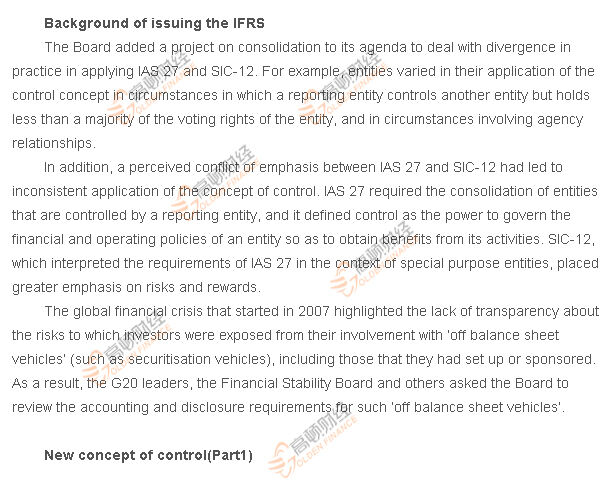高顿名师讲解2013年ACCA考试F7/P2知识考点1
New Concept of Control in IFRS10
- Relevant to paper F7/P2
IFRS 10 Consolidated Financial Statements establishes principles for the presentation and preparation of consolidated financial statements when an entity controls one or more other entities.
The IFRS supersedes IAS 27 Consolidated and Separate Financial Statements and SIC-12 Consolidation—Special Purpose Entities and is effective for annual periods beginning on or after 1 January 2013. Earlier application is permitted.
This article addresses on the background of issuing IFRS10 and the first part of new concept of control as stated in the IFRS.

1.Definition of control
An investor controls an investee when it is exposed, or has rights, to variable returns from its involvement with the investee AND has the ability to affect those returns through its power over the investee.
This definition indicates that an investor controls an investee if and only if the investor has ALL the
following:
(a) power over the investee;
(b) exposure, or rights, to variable returns from its involvement with the investee ; AND
(c) the ability to use its power over the investee to affect the amount of the investor’s returns
2.How to identify the existence of control?
To determine whether it controls an investee an investor shall assess whether it has ALL the following:
(a) power over the investee;
(b) exposure, or rights, to variable returns from its involvement with the investee; AND
(c) the ability to use its power over the investee to affect the amount of the investor’s returns.
Consideration of the following factors may assist in making that determination:
(a) the purpose and design of the investee;
(b) what the relevant activities are and how decisions about those activities are made.
When assessing control of an investee, an investor shall consider the nature of its relationship with other parties.
2.1 Purpose and design of an investee is essential.
When assessing control of an investee, an investor shall consider the purpose and design of the investee .
For example, An investee may be designed so that voting rights are not the dominant factor in deciding who controls the investee, such as when any voting rights relate to administrative tasks only and the relevant activities are directed by means of contractual arrangements. In such cases, an investor’s consideration of the purpose and design of the investee shall also include consideration of the risks to which the investee was designed to be exposed, the risks it was designed to pass on to the parties involved with the investee and whether the investor is exposed to some or all of those risks. Consideration of the risks includes not only the downside risk, but also the potential for upside.
2.2Assessing power
An investor has power over an investee when the investor has existing rights that give it the current ability to direct the relevant activities, ie the activities that significantly affect the investee’s returns.
For the purpose of assessing power, only substantive rights and rights that are not protective shall be considered.
The determination about whether an investor has power depends on the relevant activities, the way decisions about the relevant activities are made and the rights the investor and other parties have in relation to the investee.
Power and rights
Power arises from rights. The rights that may give an investor power can differ between investees.
Examples of rights that, either individually or in combination, can give an investor power include but are not limited to:
l rights in the form of voting rights (or potential voting rights) of an investee);
l rights to appoint, reassign or remove members of an investee’s key management personnel who have the ability to direct the relevant activities;
l rights to appoint or remove another entity that directs the relevant activities;
l rights to direct the investee to enter into, or veto any changes to, transactions for the benefit of the investor;
l other rights (such as decision-making rights specified in a management contract) that give the holder the ability to direct the relevant activities.
Sometimes assessing power is straightforward, such as when power over an investee is obtained directly and solely from the voting rights granted by equity instruments such as shares, and can be assessed by considering the voting rights from those shareholdings.
In other cases, the assessment will be more complex and require more than one factor to be considered, for example when power results from one or more contractual arrangements.
Only substantive rights and rights that are not protective shall be considered.
For a right to be substantive, the holder must have the practical ability to exercise that right. Determining whether rights are substantive requires judgment, taking into account all facts and circumstances.
Factors to consider in making that determination include but are not limited to:
l Whether there are any barriers (economic or otherwise) that prevent the holder (or holders) from exercising the rights.
l When the exercise of rights requires the agreement of more than one party, or when the rights are held by more than one party, whether a mechanism is in place that provides those parties with the practical ability to exercise their rights collectively if they choose to do so. The lack of such a mechanism is an indicator that the rights may not be substantive.
l Whether the party or parties that hold the rights would benefit from the exercise of those rights
Protective rights relate to fundamental changes to the activities of an investee or apply in exceptional circumstances. Because protective rights are designed to protect the interests of their holder without giving that party power over the investee to which those rights relate, an investor that holds only protective rights cannot have power or prevent another party from having power over an investee.
Examples of protective rights include but are not limited to:
l a lender’s right to restrict a borrower from undertaking activities that could significantly change the credit risk of the borrower to the detriment of the lender.
l the right of a party holding a non-controlling interest in an investee to approve capital expenditure greater than that required in the ordinary course of business, or to approve the issue of equity or debt instruments.
l the right of a lender to seize the assets of a borrower if the borrower fails to meet specified loan repayment conditions.
Rights might have yet to be excersiced.
To be substantive, rights also need to be exercisable when decisions about the direction of the relevant activities need to be made. Usually, to be substantive, the rights need to be currently exercisable. However, sometimes rights can be substantive, even though the rights are not currently exercisable.
Therefore, an investor with the current ability to direct the relevant activities has power even if its rights to direct have yet to be exercised. Evidence that the investor has been directing relevant activities can help determine whether the investor has power, but such evidence is not, in itself, conclusive in determining whether the investor has power over an investee.
Prepared by Golden ACCA R&D Center
December, 2012

相关阅读
高顿名师解析2013年ACCA考试F5业绩管理知识点32013/02/18
高顿名师解析2013年ACCA考试F5业绩管理知识点22013/02/18
高顿名师解析2013年ACCA考试F5业绩管理知识点2013/02/18

















